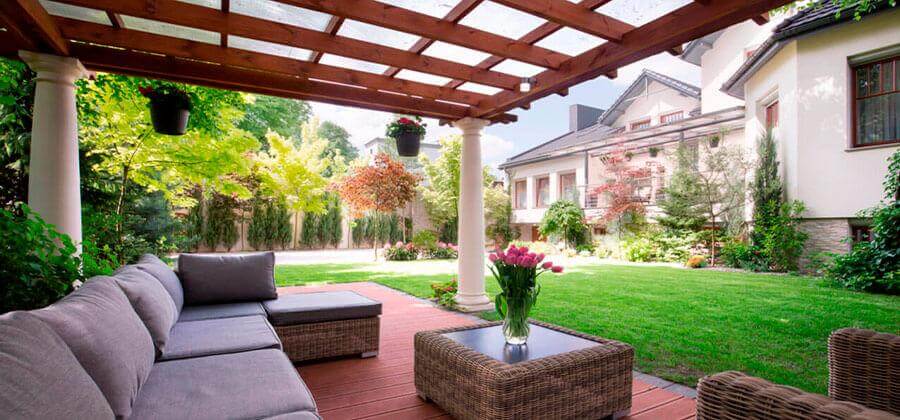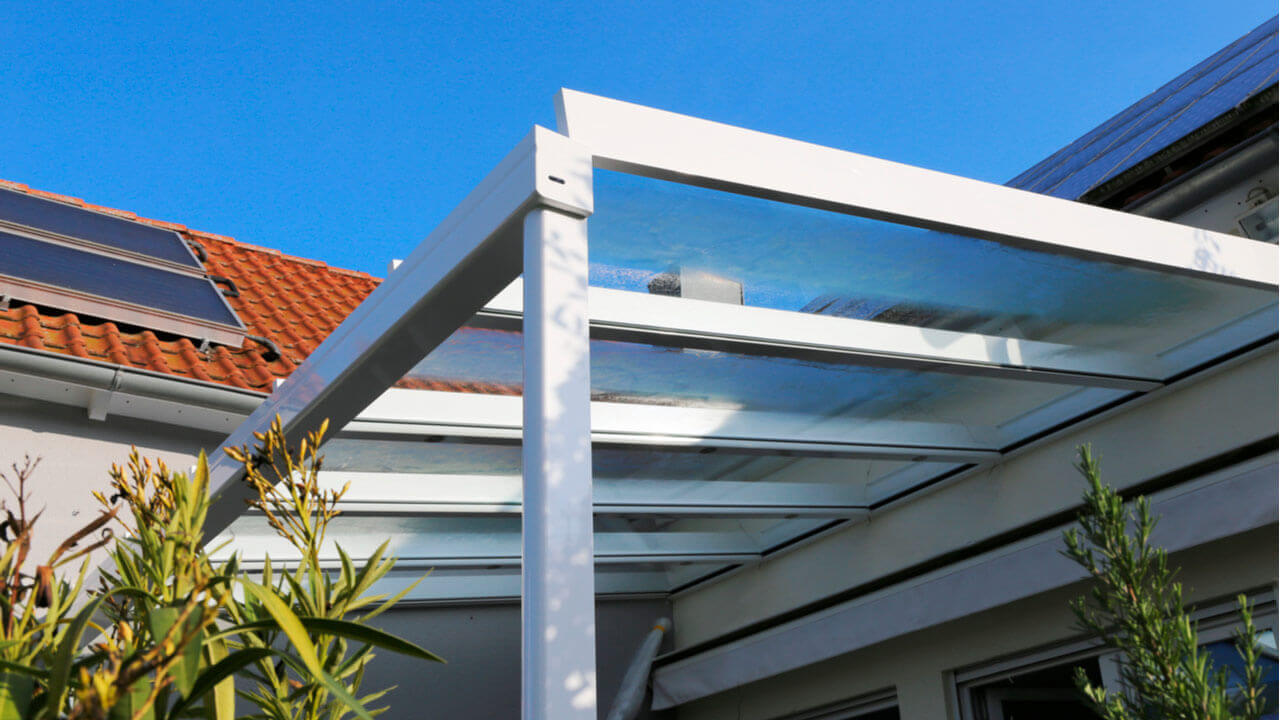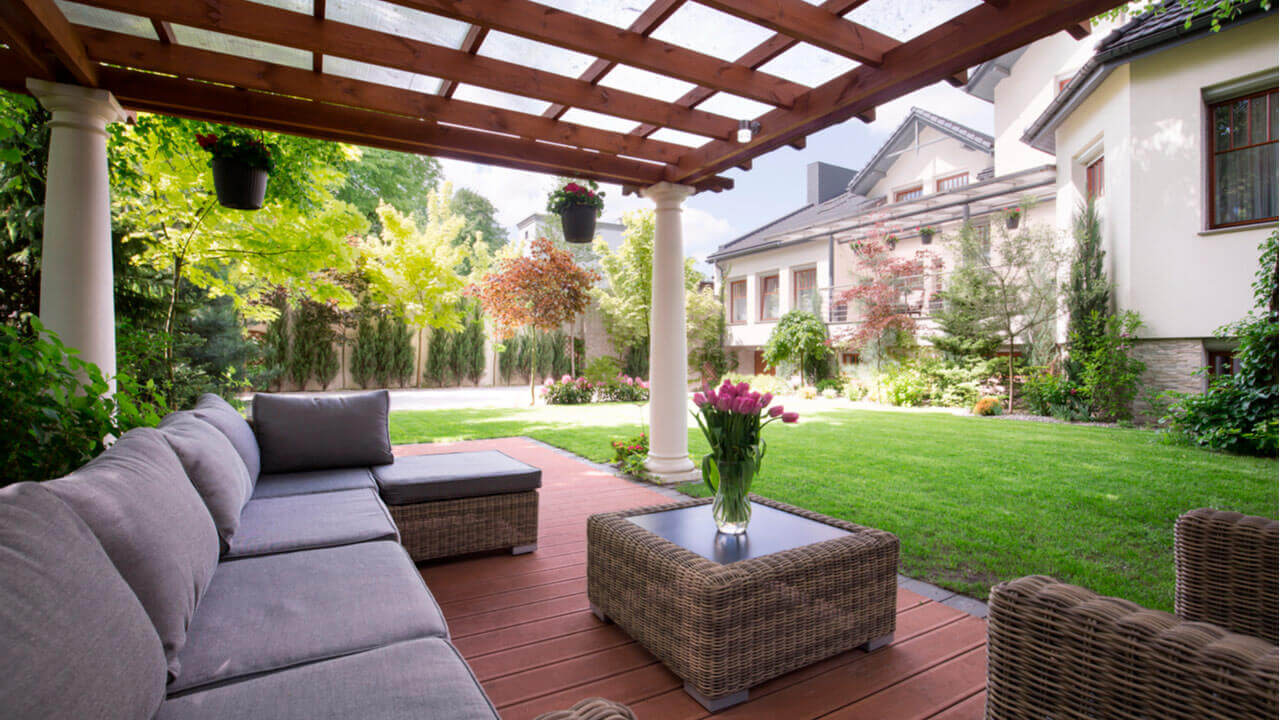
Plastic patio roofs

Find out why you should choose plastic as the material for your patio roofing and what advantages and disadvantages plastics or glass roofs have.
When it comes to choosing the right patio roof, the question of the right material for the roof structure soon arises. Here, glass and plastic are the most common variants, with the majority opting for real glass despite the higher price.
But plastic is actually much more advantageous and in many respects the better choice. In this article you will learn why you should choose plastic as the material for the roof of your terrace.
Patio roofing: why plastic is better than glass
Plastic roofing is durable, easy to work with and, above all, significantly cheaper than glass. Both polycarbonate and acrylic glass are suitable as a roof construction for a patio roof and are similar in many properties. So what is the difference between the two materials? Which is the right one for you?
Plastic roofing
 Source: www.hausundgarten-profi.de
Source: www.hausundgarten-profi.de
Polycarbonate patio roofs
The polycarbonate is a modern and perfectly shatterproof glazing that is well suited for outdoor use. The biggest advantage here is probably the impact resistance, as this material is almost unbreakable and also more resilient than acrylic glass. It is also much cheaper and lighter than glass, which is why it is suitable for a wide variety of support constructions. Polycarbonate is very robust and durable, as it is a weatherproof and weather-resistant material. Despite its high transparency, it is UV-resistant and lets much less heat through than glass. This makes it possible to enjoy the terrace in the summer and additional sun protection for the roof is not necessary.
-
The biggest advantages of polycarbonate at a glance:
- Very affordable
- Resilient and unbreakable
- Durable: Stable and weatherproof
- Low weight
- Transparent or tinted
- UV-resistant
 Source: www.hausundgarten-profi.de
Source: www.hausundgarten-profi.de
Acrylic terrace roofs
Acrylic glass is even slightly cheaper than polycarbonate. The material, also known as Plexiglas®, is an ideal and, despite everything, cheaper substitute for glass with less weight.
In terms of its properties, acrylic glass is very similar to polycarbonate. The only significant differences are in sensitivity, light transmission and price. Plexiglas is somewhat heavier and more sensitive to breakage, but still up to eleven times safer than real glass. It is also scratch-resistant and therefore retains its beautiful appearance for a long time. Despite its UV resistance, it is highly transparent and even has a higher light transmission than glass. Acrylic glass can be easily processed in a variety of ways: It can be sawn, laser-cut, glued, drilled and even deformed due to its thermoplasticity.
-
The biggest advantages of acrylic glass at a glance:
- More economical than glass
- Highly transparent
- Scratch-resistant
- Weatherproof
- Good to work with
 Source: www.hausundgarten-profi.de
Source: www.hausundgarten-profi.de
Terrace canopies made of real glass
Terrace canopies made of conventional glass
Besides the high price, there is another property of glass that clearly speaks against this material: it can break. Glass has a lower load-bearing capacity and quickly breaks under heavy loads such as snow and ice. If it is used for roofing, there is a risk of injury or even death.
Terrace canopies made of laminated safety glass
Therefore, only so-called laminated safety glass (LSG) is suitable for the roof construction of a terrace roof. This consists of two individual panes of glass that are bonded together with a film. If the roof breaks, most of the shards and splinters adhere to the laminated film, which considerably reduces the risk of injury. However, there is always a residual risk when using glass as a patio roof, which is not the case with plastic.
Even if it is a beautiful sight: a terrace roof made of glass brings more disadvantages than advantages and can also be dangerous for people.
As a patio roof, glass has several disadvantages compared to plastic. It is not only significantly more expensive, but also heavier. Processing and installation are much more complicated. Glass is not nearly as robust as plastic, because it is much more susceptible to breakage and has less load-bearing capacity, which results in a shorter service life. In addition, glass lets more heat through, which is why additional sun protection is often necessary. This leads to additional costs.
Patio roofs: Things to know
In the Building Code, terrace roofs are described as a 'structure built in open construction that is connected to a building'. Features such as a limited perimeter and size are important here, as the canopy should be minor in comparison to the building.
Another important point is the building permit, which is absolutely necessary for construction above certain dimensions. On the website of the Haus & Garten Profi you can find out everything about patio roofs and building permits. You should also take your time when choosing the material for the basic framework, as there are many differences in terms of both price and structural engineering.
CONCLUSION:
As is clear, plastic has numerous advantages and is in no way inferior to glass. On the contrary, plastic is significantly more resilient, safer and at the same time cheaper than glass. Due to their diversity and easy handling, both polycarbonate and acrylic glass are suitable as roofing for pretty much any terrace.
All the plastics we offer in our online shop comply with the REACH and RoHs directives, are non-toxic, resource-conserving and fully recyclable, thus protecting both people and the environment. Our online shop makes it easy to buy various plastics online with fast delivery. We cut the plastic sheet for your patio roof not only individually and exactly, but also at best prices. For larger orders, there are of course quantity discounts, which our online shop takes into account completely automatically. Our expert advice will be happy to help you choose the right material for the roof structure of your patio roof.
We hope you enjoy your new patio roof!
The images were kindly provided to us by www.hausundgarten-profi.de.